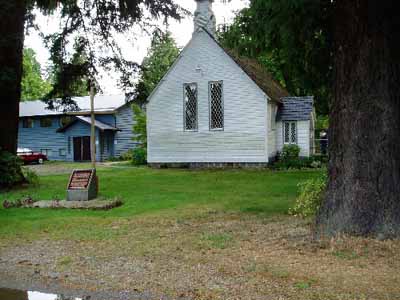Christ Church National Historic Site of Canada
Hope, British Columbia

Corner view
© Parks Canada Agency / Agence Parcs Canada, 2008.
Address :
681 Fraser Street at Park Street, Hope, British Columbia
Recognition Statute:
Historic Sites and Monuments Act (R.S.C., 1985, c. H-4)
Designation Date:
1994-11-24
Dates:
-
1861 to 1861
(Construction)
Event, Person, Organization:
-
Rev. George Hills, Bishop of Diocese of Columbia
(Person)
-
Captain John Grant, Royal Engineers
(Architect)
Other Name(s):
-
Christ Church
(Designation Name)
Research Report Number:
1994-032
Plaque(s)
Existing plaque: 681 Fraser Street at Park Street, Hope, British Columbia
Built in 1861, Christ Church is a fine example of the mid-19th-century revival of mediaeval Gothic forms in religious architecture. This use of traditional models reinforced the broader role of the Anglican church as a stabilizing influence in a turbulent gold-rush community. Designed by the Royal Engineers, the building features a side entrance beneath a bell tower, leading to an interior focused on an altar placed within a raised chancel. Christ Church is a charming reminder of the early years of the province's history and remains a vital part of community life.
Description of Historic Place
The Christ Church National Historic Site of Canada is a modest, beautifully crafted wooden structure designed in the Gothic Revival style located in the town of Hope, British Columbia. The building’s design is composed of clearly distinguishable nave and chancel sections and a side entrance porch, all covered with gable roofs. The exterior is clad with clapboard siding and displays square-headed windows and a Gothic style doorway. The building’s historic character is enhanced by its beautiful setting on a large, well-maintained lot surrounded by mature fir trees. The official recognition refers to the church on its property.
Heritage Value
Christ Church was designated a national historic site of Canada in 1994 because: it is a fine example of Anglican parish church architecture in the Ecclesiological Gothic Revival style; it is one of the best-preserved churches in Western Canada and the oldest church in British Columbia on its original foundation; it is representative of the response of the British church and state to the social and political conditions created by the Fraser River and Cariboo gold rushes in colonial British Columbia.
Associated with the Church of England, the ecclesiological Gothic Revival architectural movement called for a return to more traditional forms of church design, rooted in English architecture of the Middle Ages. Features, such as the side entrance with a Gothic style doorway, a bell tower, and clear separation of nave and chancel in visibly distinct building volumes, were characteristic of this style. Inside, the separation of the nave from the chancel was reinforced by the use of a chancel rail and by elevating the chancel three steps above the nave.
Christ Church was one of approximately 14 similar Anglican churches built in British Columbia between 1859 and 1866 under the direction of Bishop George Hills and executed under the auspices of the Corps of Royal Engineers stationed in British Columbia at the height of the Gold Rush era. The construction of these churches was a part of a concerted plan to establish British institutions in the new colonies of Vancouver Island and Mainland British Columbia. At Christ Church, these objectives were clearly expressed through the high quality of construction and strict adherence to “high church” standards of design, demanded by Bishop Hills and provided by the Royal Engineers and local builders. Christ Church is one of the oldest-surviving and best-preserved churches in western Canada.
Source: Historic Sites and Monuments Board of Canada, Minutes, November 1994.
Character-Defining Elements
The key elements relating to the heritage value of this site include: the continuous function of the building as a place of worship; the spirit and design of the surrounding landscape; the exterior forms, massing and design features of the building that are associated with
Gothic Revival style design principles as advocated by the Ecclesiological Reform movement including the distinction between nave and chancel as separate volumes defined on the interior by use of a chancel rail and elevation of the chancel by three steps, the separate side entrance porch with a Gothic style side entry, bell-tower and roof cresting; the original exterior wall surfaces, door, windows with diamond-shaped glass panes and hand-made sashes; the original interior fittings including an octagonal pulpit, chancel rail, handcut screens, lectern, and pews; the varnished board and batten interior wall surfaces, exposed varnished roof surfaces and painted truss system with chamfered truss members.